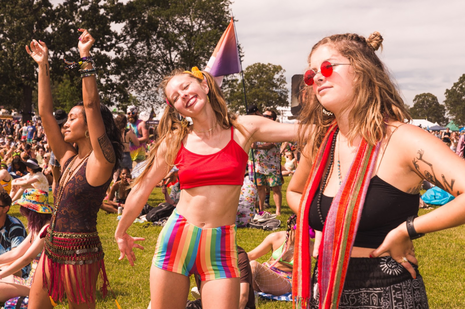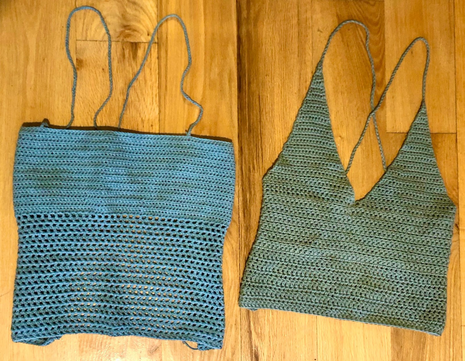Raving responsibly: your guide to sustainable festival fashion
Festival season is here, and with it comes a mad rush for fast fashion. Katerina Long guides us through how to keep our wardrobes sustainable

The season rolls around again for us to stuff our barely-there outfits among mouthwash bottles and toothpaste tubes, which are just vessels for the substances to get us through the weekend-long bender known as British festivals. Whether you are looking forward to Glastonbury, Reading, or Wireless, aside from the strict regime of dedicating your Spotify to the artists playing, choosing an outfit forms a crucial part of the preparation process. With the return of festival season comes festival fashion!
If there’s one thing more synonymous with festivals than revelling in the sun and coughing up black dust for days after, it is fast fashion. Colourful crochet pieces, funky trousers, sequined dresses and copious amounts of glitter are all illustrations of fads that are as fickle as they are flashy. Festival fashion has come to symbolise throw-away pieces that are too garish and excessive to be integrated into your everyday wardrobe. Consumers are deterred from buying higher quality items if they are to be worn for one day only and discarded immediately after; the cycle continues. While you are busy raving, landfills are heaving, and Mother Nature is weeping.
Despite this pessimistic sentiment, the solution is almost painfully simple and can be summarised in the words of the icon Vivienne Westwood herself: “buy less, choose well, make it last”. This piece is my own slightly warped version of her advice (apologies in advance, Viv):
Go casual
Celebrities at Coachella festival this April have set the tone for this year’s festival season by breaking with the seemingly legal contract of the festival’s “uniform”. The likes of Kendall Jenner and Hailey Bieber made the audacious move to wear the unlikely combination of jeans and a cropped top. Wow, so avant garde! Some have speculated whether this minimalist dressing symbolises status, which shows wealth can be flaunted without overdressing in costume-like outfits that have previously graced the festival. Critics theorise that these A-listers are differentiating themselves from the “new-money” influencers who strive for attention.
While we, as ordinary people, do not necessarily fit into the discourse of new versus old money, we should still consider the benefits of dressing comfortably. Ultimately, we can all agree that waiting six hours for Lewis Capaldi to come on stage is much more pleasant when an ill-fitting pair of cowboy boots is not torturing your feet. Incorporating some of your daily items into your festival outfit makes it: a) an overall more bearable experience, b) a lot more environmentally friendly than buying new pieces, and c) allows you to pretend that you’re an A-lister whose low-key dress is a tactic of anonymity while under the paparazzi’s gaze.
Gorpcore
Gorpcore is a style centered around wearing functional, utilitarian, outdoors-inspired gear. If we treat festivals like what they are, a glorified D of E expedition – with the addition of some music – zip-off trousers and walking boots should be all the rage. Understandably, some people aren’t entirely willing to sacrifice aesthetics for functionality, but they are not incompatible.
Outdoor brands such as Patagonia are taking admirable action in reducing their environmental impact; the company aims to use fabrics wholly made from recycled materials, even synthetic fibres. The brand rejects fast fashion in favour of high-quality items that will not end their life in landfills, due to the repair and reuse scheme they support, called “Worn Wear”. They have even gone so far as to discourage their customers from falling victim to faddish fashion and buying too many of their products with their “Don’t buy this jacket” campaign.
Brightly coloured fleeces and waterproof jackets are the “camping chic” staples for the British festivals, which have come to be interchangeable with images of revellers neck deep in muddy water. Fundamentally, a music festival is an outdoor experience, so incorporating elements of gorpcore into your outfits is an eco-conscious and practical approach to festival fashion.
“Festivals should continue to be a celebration of music, art and sustainable living, instead of a runway for the latest fleeting fads”
DIY
Making your clothes is wonderful for the planet, and those with an individuality complex who can’t be caught within a two-mile radius of someone with the same, equally basic Zara top without feeling unbridled amounts of shame.
Crochet is one of the trends on the festival fashion radar. The gaps in the fabric are ideal for an easy-breezy look and, simultaneously, peculiar tan lines. Yet, these seemingly inoffensive pieces have dark origins. Crochet is too complicated to be created by a machine and, therefore, can’t be mass-produced like knitwear. All crochet items are made by hand, and this hand in question usually belongs to an exploited worker in a sweatshop. So watch a YouTube video, take a crochet class, and avoid Shein at all costs. If you weren’t looking for a piece that will last you longer than a weekend anyway, then there is no harm for even the most artistically inept to try their hand at a DIY.

Festivals should continue to be a celebration of music, art and sustainable living, instead of a runway for the latest fleeting fads. No one desires to look like they were copied and pasted from the Shein homepage when there are many affordable and ethical alternatives.
 Comment / Plastic pubs: the problem with Cambridge alehouses 5 January 2026
Comment / Plastic pubs: the problem with Cambridge alehouses 5 January 2026 News / Cambridge academics stand out in King’s 2026 Honours List2 January 2026
News / Cambridge academics stand out in King’s 2026 Honours List2 January 2026 News / Cambridge businesses concerned infrastructure delays will hurt growth5 January 2026
News / Cambridge businesses concerned infrastructure delays will hurt growth5 January 2026 News / AstraZeneca sues for £32 million over faulty construction at Cambridge Campus31 December 2025
News / AstraZeneca sues for £32 million over faulty construction at Cambridge Campus31 December 2025 Interviews / You don’t need to peak at Cambridge, says Robin Harding31 December 2025
Interviews / You don’t need to peak at Cambridge, says Robin Harding31 December 2025









